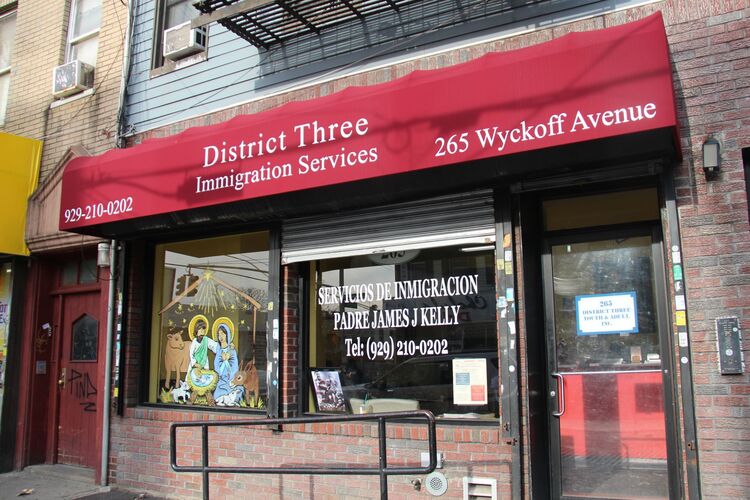The Rev. Bernard Quinn faced opposition from the Ku Klux Klan on Long Island.
By Geoffrey Cobb
In 1983, African-American priest Fr. Paul Jervis was assigned to the parish of St. Peter Claver in Brooklyn, which had been founded in 1921 by Fr. Bernard Quinn, as Brooklyn’s first black Catholic parish. Speaking with his parishioners, Jervis was amazed to hear the stories of so many older people who still spoke of Quinn with profound reverence, even though he had died 43 years earlier.
Intrigued, Jervis began to research his predecessor and was so taken with Quinn’s life that he decided to write a biography of Quinn calling it: “Quintessential Priest, The Life of Father Bernard J. Quinn.” Jervis’s biography is an inspirational tale of a man whose love for his black congregation defined him and forged a unique community of faith.
Quinn was born in 1888 in Newark, N.J., into a large Irish Catholic family. His father, who was from County Cavan, and his County Offaly mother sent him to parochial school and young Bernard felt such a strong vocation that he entered the seminary in 1906, where he developed a lifelong deep sympathy for the poor and the downtrodden. Ordained in 1912 in Brooklyn, Quinn was assigned to diocesan parishes such as St. Patrick’s in Bay Ridge and St. Gregory the Great in Crown Heights.
When World War I erupted, Quinn volunteered to serve as a chaplain for front line troops. Commissioned as a First Lieutenant, Quinn served as chaplain of the 333rd infantry. Serving at the front, he became a victim of mustard gas. Though he recovered, Quinn suffered from the gassing for the rest of his life. In France, Quinn was shocked by the racism in the American army. When a white American Protestant chaplain refused to pray with a dying Black soldier, Quinn intervened and prayed with the dying soldier, but the troubling incident lingered with Quinn.

Fr. Quinn was shocked by the racism he observed in the U.S. army during World War I.
The war ended, but Fr. Quinn remained in France to minister to the wounded soldiers. After a chance reading of “The Story of a Soul, the life of St. Therese of Lisieux,” in the barracks library, Fr. Quinn discovered a spiritual hero. Learning that he was stationed in the vicinity of Alencon, not far from St. Therese childhood home, Quinn obtained permission to visit it and became the first priest to celebrate Mass there before it became a popular shrine. Intense devotion to St. Therese would define Fr. Quinn’s faith for the rest of his life.
Quinn returned to Brooklyn in 1919. While preparing two black women for baptism, he was inspired to create an apostolate to African Americans, but his concern for Blacks was not shared by all Brooklyn’s Catholics, some of whom did not want African Americans praying in their churches. After repeated appeals, Quinn finally received permission from Bishop McDonnell to begin his mission to the Black people of Brooklyn, but finding Black Catholics proved difficult. Quinn went to the streets, asking every African American he met where he could find Catholics. Finally, Quinn found Mr. Jules de Weever, the leader of the dissolved Colored Catholic Club, which had met from 1915-1916, seeking in vain to establish a church for Black Catholics in Brooklyn. Frustrated by the church’s indifference to their quest, the group disbanded. Quinn revived the CCC and inspired them to persevere in founding Brooklyn’s first Catholic church.

The Rev. Bernard Quinn with young parishioners of St. Peter Claver.
Quinn incessantly petitioned the bishops for permission to establish an African-American parish, reminding them that Black Catholics were being excluded from worship at Italian, Irish and German churches, but instead of agreeing, the bishops ignored Quinn’s pleas. Finally, thanks to his perseverance, they authorized the founding of Brooklyn’s first African American Catholic Church, St. Peter Claver Church, in 1921, naming Quinn pastor.
The Irish-American priest now needed a church building and the parish soon found a warehouse for trunks and baggage that had once been a Congregationalist church on the corner of Ormond Street, now Peter Claver Place, and Jefferson Avenue, in the expanding black community of Bedford Stuyvesant. Quinn and the congregation enthusiastically set to work on the herculean task of transforming the warehouse back into a house of worship. The church’s decoration celebrated black faith with murals of early Black saints, and of St. Peter Claver’s work with enslaved Africans in Cartagena, Colombia.
On Christmas Day, 1921, the cornerstone for St. Peter Claver, named for the patron saint of African peoples, was laid. By 1922, the church was ready and blessed by Bishop Thomas Edmund Molloy. Quinn soon proved to be a model pastor and quickly the kindhearted priest endeared himself to his rapidly growing flock. Brooklyn’s Black Catholics were attracted to a church that didn’t just tolerate them, but even welcomed them with open arms. The parish became more than a place to pray, helping the parish’s poor, while also setting up a clinic, a credit union, a parish school, and adult education classes. St. Peter Claver soon became famous for its large children’s choir and its band. Legendary entertainers Lena Horne and Pearl Bailey both started their singing in the church’s choir. Reputedly, it was the first African-American choir ever to sing at the prestigious Brooklyn Academy of Music.
Fr. Quinn began a temporary daily novena, a series of prayers, to his inspiration, St. Thérèse, called the Little Flower Novena, but he never could have imagined the massive reaction the novena received. People begged for the novena to continue and an estimated that 10,000 of all races a week poured into St. Peter Claver’s. Within five years an amazing 2.2 million people had attended the novena, stirring the envy of nearby white Catholic pastors who complained that it drew away their parishioners. The novena was such a hit that the drivers on the bus line near the church would call out “Little Flower Novena stop.” The Brooklyn Daily Eagle soon did a feature article on the amazing success of the novena.
The novena proved to be a huge money maker for the parish, allowing Fr. Quinn to fund some of the parish projects he envisioned including a $300,000 school building, a convent, a recreation center and a Long Island orphanage that would ignite the bitter flames of racism. In 1929, Msgr. Quinn founded the Brooklyn Diocese’s first orphanage for Black children in a farmhouse in Wading River, Long Island, which at the time was still part of the diocese. A cross was burned in front of the Quinn family home in Mineola, but the priest defied the threat. Outraged racist locals contacted the Ku Klux Klan, which was very active on Long Island in the 20s and 30s, and the orphanage burned in an act of arson. The orphanage was rebuilt but burned again in the same year.
Undeterred, Father Quinn rebuilt the orphanage yet again, this time in stone and brick. The Brooklyn Eagle announced this with a headline, “New Fireproof Orphanage Will Defy Incendiary.” The KKK gave up, and the orphanage, called the Little Flower Orphanage, in honor of St. Thérèse, was dedicated as the Little Flower House of Providence Oct. 26, 1930. Today that organization survives as the Little Flower Children and Family Services of New York, offering adoptions and other social services in Brooklyn, Queens and Long Island.
Quinn became an outspoken defender of Brooklyn’s Blacks against the pervasive racism of his day. He denounced institutionalized racism and invited the Urban League, an African American advocacy group, to speak at his church. Some Brooklyn Catholic clergy spoke out against Quinn’s embrace of Black Catholics. In 1929, Msgr. John L. Bedford wrote in his Brooklyn parish newsletter that “Negroes should be excluded from this Roman Catholic Church if they become numerous.” Quinn vehemently defended his flock writing in the Brooklyn Tablet, “It seems to me that no church can exclude anyone and still keep its Christian ideals. The Constitution guarantees the freedom of religion and this, plus the fact that church property is tax exempt, ought to mean that anyone can go anyplace to worship.”
The strain of his herculean labors took a physical toll on Quinn. In the spring of 1940, Msgr. Quinn went into nearby St. Mary’s Hospital for surgery for an abdominal problem. He never came back to St. Peter Claver’s, dying on April 7. Brooklyn’s Black Catholics were in shock. They had lost a dear friend and their most vocal advocate. Eight thousand grieving mourners attended his funeral at St. Peter Claver, which was reported in all the New York papers including the New York Times.
In 1992, a movement to canonize Msgr. Quinn received the blessing of the Catholic Church and the long and difficult path to Quinn’s canonization has started. Decades before the founding of the Black Lives Matter movement, Fr. Quinn dedicated his life to serving Brooklyn’s Black Catholics and his life remains a shining example of the power of love to defeat hatred and bigotry.
Author and teacher Geoffrey Cobb will lead a walking tour on Saturday, Aug. 7, of sites associated with the Tipperary-born Paddy "Battle Axe" Gleason, who was the last mayor of Long Island City before its 1898 incorporation into New York City. The event is sponsored by the New York Irish Center, 10-40 Jackson Ave.







